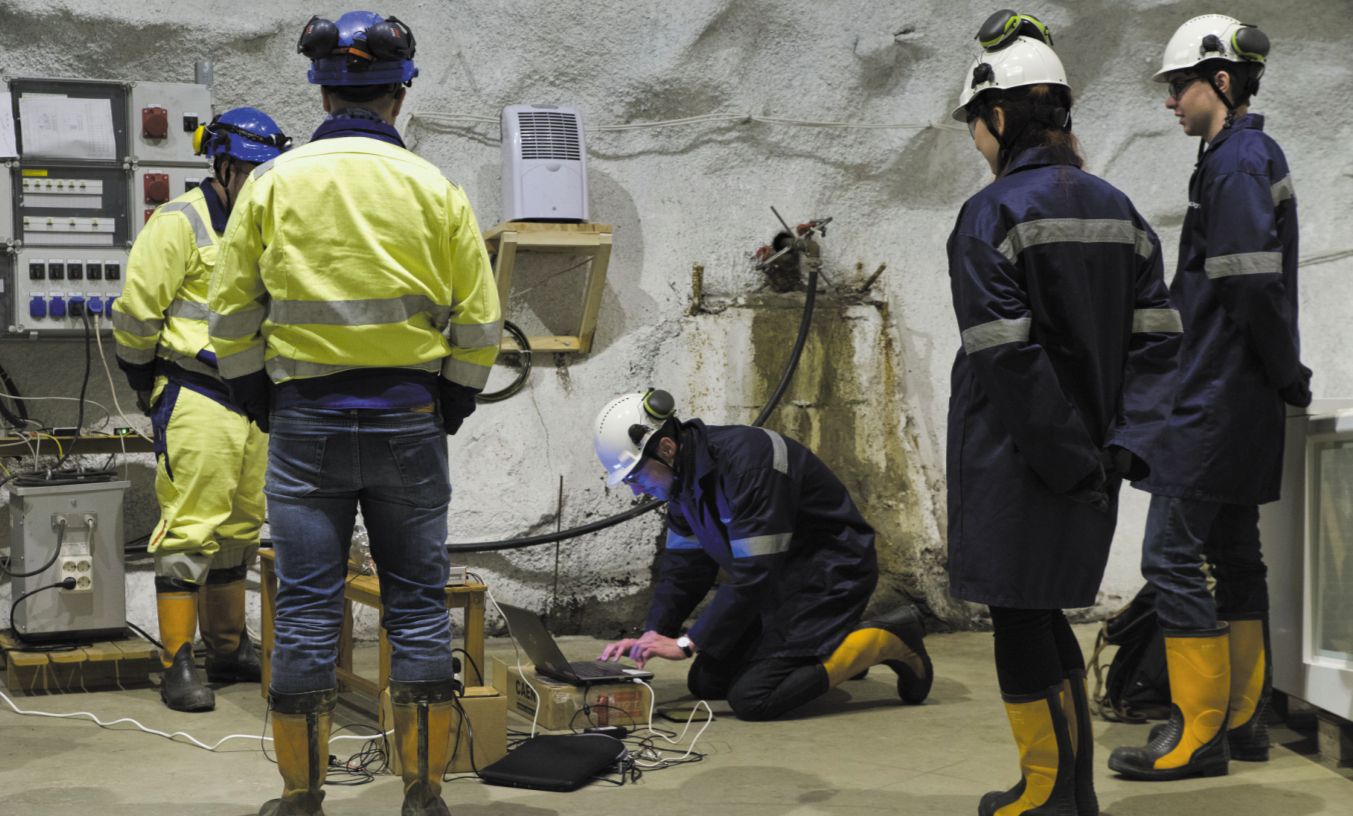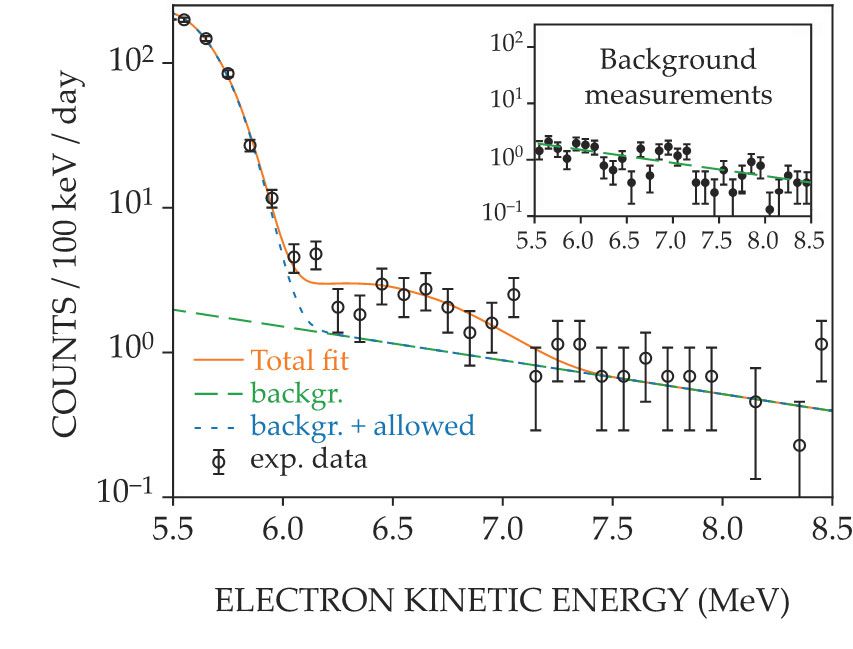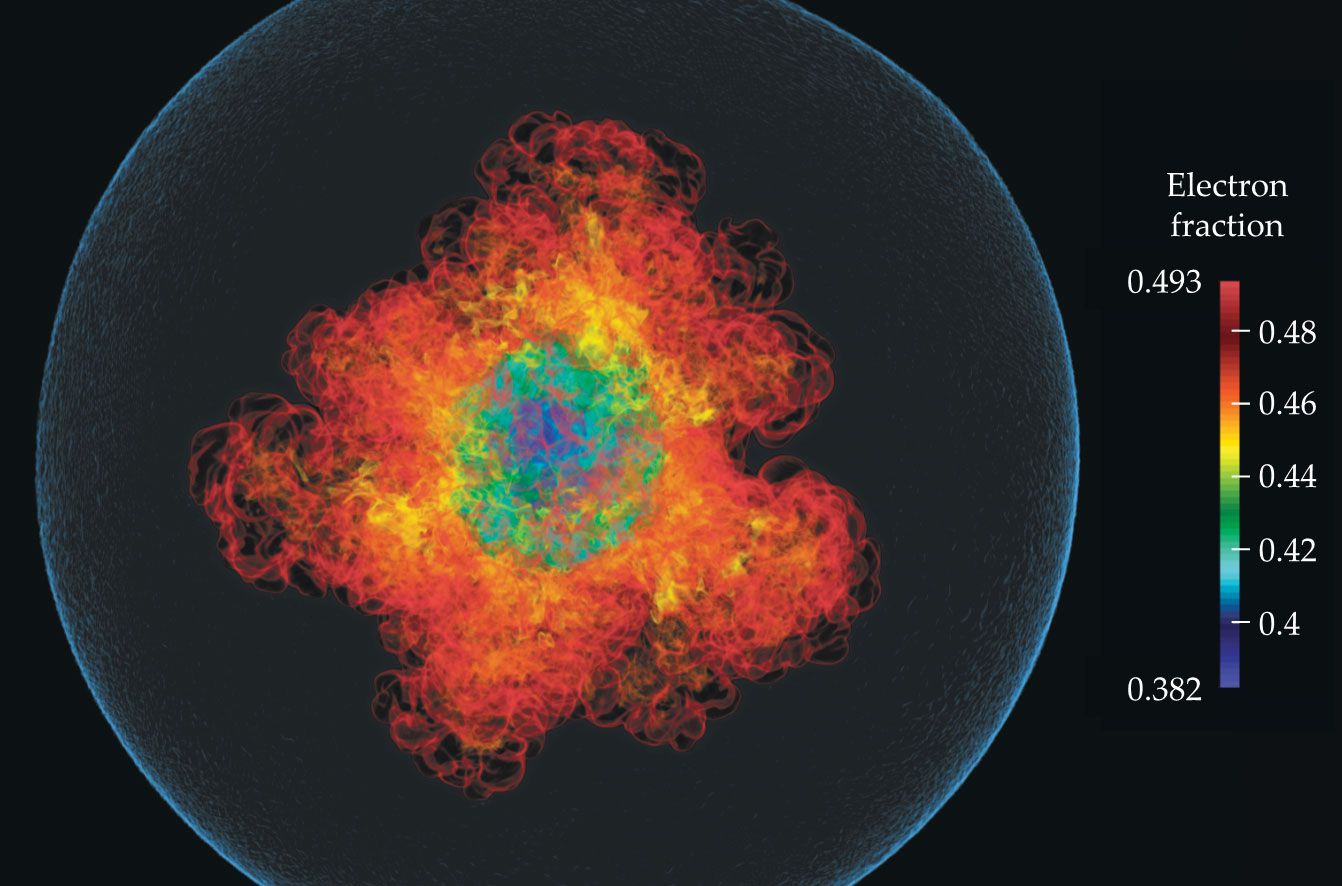Rare nuclear transition provides evidence for stellar explosion mechanism
DOI: 10.1063/PT.3.4425
When the core of a massive star runs out of nuclear fuel, it collapses under its own gravity to form a neutron star or a black hole and sheds its outer layers in a supernova. (See, for example, the article by Hans Bethe, Physics Today, September 1990, page 24
To understand the fate of a star, astrophysicists must delineate the nuclear reactions that occur in its core after the main fuel-burning cycle ends. At that point, stars in the range of 7–11 solar masses have cores that consist mainly of oxygen and neon. Theoretical models of stellar evolution predict which reactions happen next. Particularly important is a reaction sequence in which an atomic nucleus absorbs an electron, which combines with a proton to form a neutron. In that sequence, a high-energy (7 MeV) electron is absorbed by neon-20 to form fluorine-20, which promptly captures another electron to form oxygen-20. As a by-product of that reaction chain, gamma radiation is released and heats the stellar core enough to trigger the ignition of oxygen. Whether the energy liberated by oxygen ignition is enough to forestall collapse or trigger an explosion depends critically on the density at which the onset of electron capture on 20Ne takes place.
A team led by Oliver Kirsebom (now at Dalhousie University in Nova Scotia, Canada) and Gabriel Martínez-Pinedo (GSI Helmholtz Center for Heavy Ion Research and Technische Universität Darmstadt in Germany) has recently found that the electron capture on 20Ne occurs at lower densities and with a higher rate than previously expected. The researchers inferred experimentally the chain’s first and rate-limiting step—the capture of electrons by 20Ne—under conditions that prevail in a stellar interior. Stellar models based on the new rate suggest that thermonuclear explosion is the common end for many of our galaxy’s stars. 1 , 2
Forbidden transition
Atomic nuclei have different energy states. Which one a nucleus is most likely to inhabit depends on the temperature and density of the environment. At the temperatures in oxygen–neon stellar cores, most 20Ne exists in its ground state. As the stellar core evolves, its density grows and the energy of the electrons, which comprise a degenerate gas in the core, increases. At some point, electrons will have enough energy, 7 MeV, to link in a decay chain the ground states of Ne and F.
The rate at which Ne captures electrons during the transition between the ground states of 20Ne and 20F nuclei can be directly related to the inverse process, the beta-decay in which radioactive 20F emits an electron and produces 20Ne. Under terrestrial conditions, 20F decays to the first excited state of 20Ne. However, that ground state transition has an extremely low likelihood and is considered forbidden. Forbidden means that the reaction links nuclear states with different spins, which results in a transition that is, in this case, supressed by six orders of magnitude compared to an allowed transition between same-spin states. As a result, quantifying the rate-limiting electron capture step is difficult.
To learn more about the neon–fluorine electron capture rate, Kirsebom and colleagues looked to an allowed version of the inverse beta-decay process. The decay that connects 20F decays to the first excited state of 20Ne can produce electrons that have from zero to 5.4 MeV of kinetic energy, whereas the decay connecting the ground states of 20F and 20Ne produces electrons up to a maximum kinetic energy of 7 MeV. 3 Electrons with energies up to 5.4 MeV mostly originate from the allowed decay to the excited state of 20Ne; but any electrons with energies above 5.4 MeV must originate through the forbidden ground state decay. Kirsebom designed an experiment to measure how frequently 20F emitted electrons with energies above 5.4 MeV, and thereby determine the strength of the forbidden transition.
Earthly measurements
Because 20F decays extremely rapidly, with a half-life of 11 seconds, studying its behavior requires an advanced accelerator facility where the isotopes can be produced and quickly transported to a detection system. At the University of Jyväskylä accelerator laboratory in Finland the researchers bombarded carbon foil with a beam of 20F nuclei. The laboratory is one of the few facilities worldwide that can produce a pure, intense, low-energy 20F beam, free of contamination by other radioactive isotopes. On striking the carbon foil, the 20F nuclei became embedded. Kirsebom and his colleagues, shown in figure
Figure 1.

Olver Kirsebom, kneeling at computer, and colleagues designed an experiment at the University of Jyväskylä accelerator laboratory in Finland to measure how frequently radioactive fluorine-20 emitted electrons and decayed to ground-state neon-20. The photo was taken at 1444 m depth in the underground laboratory. (Image courtesy of Oliver Kirsebom.)

The team paid particular attention to electrons that had kinetic energies 5 MeV and above. The resulting energy spectrum in figure
Figure 2.

The energy spectrum measured during radioactive decay of fluorine-20 to neon-20 (orange) shows the count of electrons emitted at different energies during 105 hours of decay. Below 5.4 MeV, the count exceeded that emitted by background sources (green), as predicted by simulations (blue). Between 5.4 MeV and 7 MeV, the measured count exceeded the predicted count; that difference indicated occasional occurrence of 20F decay to ground state 20Ne. The inset showing the background spectrum obtained without the 20F beam confirms the forbidden transition’s contribution to the spectrum. (Adapted from ref.

The researchers concluded that 1 in 250 000 events produced 20Ne in its ground state—a rate that should match that of the reverse process. Based on the measured transition probability, and considering stellar plasma densities of 109 g/cm3, electron capture on 20Ne was determined to occur eight orders of magnitude more often than assumed by previous calculations.
Stellar implications
Numerical simulations of stellar evolution that take into account the newly measured Ne–F transition rate suggest that the star’s core begins to generate heat earlier than previous models predicted. 4 Once the core reaches 1.5 × 109 K, oxygen can fuse with itself; the earlier ignition happens, the higher the likelihood of a thermonuclear explosion.
The resulting supernova, like the one simulated in figure
Figure 3.

Numerical simulations show the supernova that results from an oxygen–neon stellar core after the newly measured neon-20 electron capture triggers a thermonuclear explosion. The color key shows the explosion’s electron fraction, which describes whether isotopes tend to be richer in protons or neutrons. For example, iron-56 has 26 protons and 30 neutrons, so its electron fraction is 26/56 or 0.464 and corresponds to the orange regions of the explosion. Iron-60 has an electron fraction of 26/60 or 0.433, corresponding to the turquoise region. The lowest electron fraction achieved in the simulation (blue) is below 0.40, which is 12% lower than regular supernovae. (Adapted from ref.

By itself, a high Ne–F transition rate isn’t enough to preordain the explosion of a 7- to 11-solar-mass star. The energy released by electron capture on 20Ne may trigger convection in the stellar core. Convection leads to mixing and could delay the onset of oxygen ignition, so that gravitational collapse would be the end of the star. Improved models of convection in the stellar core are needed.
The observation of iron-rich white dwarfs would clinch the case that the Ne–F transition drives a thermonuclear explosion. Several candidates have already been detected through observations of their atmospheres. 6 The associated explosions are expected to be characterized by specific spectral features that could, in principle, be observed. 5
References
1. O. S. Kirsebom et al., Phys. Rev. Lett. 123, 262701 (2019). https://doi.org/10.1103/PhysRevLett.123.262701
2. O. S. Kirsebom et al., Phys. Rev. C 100, 065805 (2019). https://doi.org/10.1103/PhysRevC.100.065805
3. G. Martinez-Pinedo et al., Phys. Rev. C 89, 045806 (2014). https://doi.org/10.1103/PhysRevC.89.045806
4. J. Schwab, E. Quataert, L. Bildsten, Mon. Not. R. Astron. Soc. 453, 1910 (2015). https://doi.org/10.1093/mnras/stv1804
5. S. Jones et al., Astron. Astrophys. 622, A74 (2019). https://doi.org/10.1051/0004-6361/201834381
6. R. Raddi et al., Mon. Not. R. Astron. Soc. 489, 1489 (2019). https://doi.org/10.1093/mnras/stz1618
